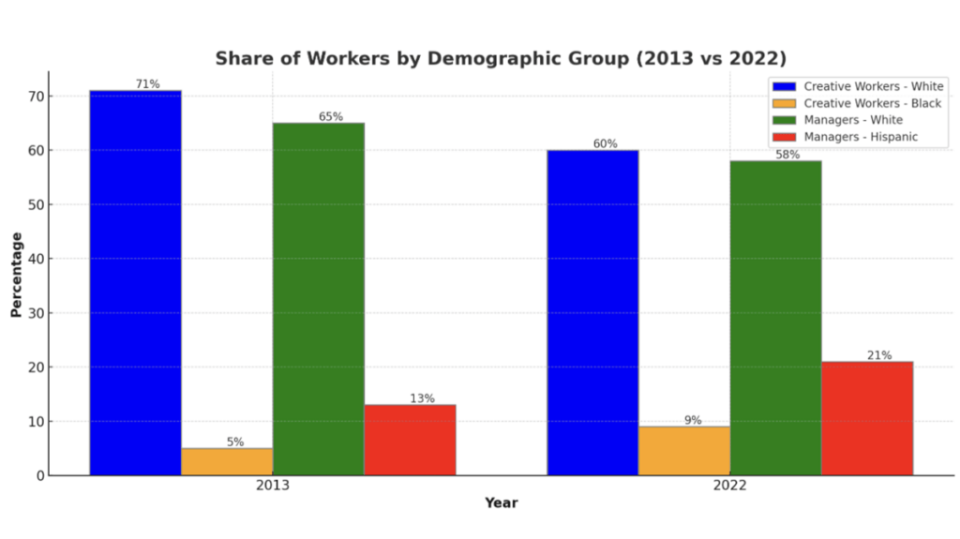As Hollywood shrinks, the industry’s workforce is becoming an increasingly “exclusive club” with a surge in “knowledge-intensive,” so-called “white collar” positions. But it’s also becoming more racially diverse, a recent study shows.
Film and TV jobs now make up a smaller share of Los Angeles entertainment industry employment than they have in 30 years. Nevertheless, the percentage of college-educated workers has shot up to 68% in 2022, from 46% in 2000. And in 2022, for the first time the majority of entertainment workers were nonwhite, according to the most recent Otis College Report on the Creative Economy.
According to the study, the share of creative workers who are white dropped from 71% in 2013 to 60% in 2022, while the share of black creative workers grew from 5% to 9%. The share of managers who are white dropped from 65% in 2013 to 58% 2022, while the share of Hispanic managers increased from 13% to 21%.
The study, co-produced with Westwood Economics and Planning Associates, underscores a stark reality: The Los Angeles-based entertainment industry, which has gone through waves of consolidation and other upheaval including the COVID-19 pandemic and double labor strikes last year, has been transformed over the past two decades from its more blue collar production roots into a higher-educated and more-diverse workforce.
That could have implications for how film and television jobs are viewed in the broader southern California economy, which has become more diversified in recent years as the tech and streaming television industries have expanded.
“Los Angeles is still the apex of the entertainment industry, but the industry itself is undergoing once-in-a-generation changes,” Patrick Adler, principal of Westwood Economics and Planning Associates, said in a statement. “It is less dependent on film and television, more oriented towards online content creation, live events and gaming, it is also more technical and managerial than ever.”
Streaming and tech jobs shifting the workforce
Jay Tucker, executive director, Center for Media, Entertainment & Sports at UCLA Anderson School of Management, observed that streaming and other digital demands have spurred the growth of more corporate jobs, rather than necessarily expanding creative positions. That being said, groups of corporate climbers bring greater diversity — along with more academic degrees — to Hollywood, he said.
Graduates of California’s universities, with their diverse student bodies, are finding “really good white collar jobs growing and prospering not just because of the studios but because of streaming and because of social media,” David Offenberg, an entertainment finance professor at Loyola Marymount University, told TheWrap.
The Los Angeles economy, meanwhile, “can handle losing some production jobs because we still have so many decision-making jobs,” Offenberg said. He added that a greater percentage of college-educated job holders in Hollywood may not necessarily represent increased elitism in the industry.


Industry experts suggested the latest employment numbers may reflect the uptick in the percentage of college grads in the general population. Others said the study’s focus on Los Angeles may underscore the increasing cost of living in the city, which has resulted in a more educated population that is more likely to be able to afford higher rents.
In L.A. County, Asians accounted for one third of the drop in the white share of film and TV workers, Blacks and Hispanics together made up a third, while “other,” which includes Native Americans, Pacific Islanders and other races not classified elsewhere, accounted for the other third. The study concluded that “the increasingly diverse college-educated pool is making its mark in Hollywood.”
What seems most relevant to drawing conclusions from the report is that what most people refer to as Hollywood — TV and film content production — is only part of the picture.
For the Otis College study, TV and film are lumped together with sound, broadcasting and print media, the latter of which continued its long decline with waves of layoffs in 2024 at legacy print publications such as the Los Angeles Times and Sports Illustrated. Print media employment dipped 9.1% from 2013 to 2024, representing 12,900 jobs in greater Los Angeles.
[Los Angeles] is less dependent on film and television, more oriented towards online content creation, live events and gaming, it is also more technical and managerial than ever.
Patrick Adler, principal of Westwood Economics and Planning Associates
The Otis report points to the L.A. region’s share of national film and TV employment as a separate entity from other areas of “greater entertainment,” including software publishers, media streaming, performing arts, spectator sports and related industries, and independent artists. And there’s good news on that front: In those areas, employment is up 53%, or 28,000 jobs, over the same 10-year period.
The report is second installment of a study released in December which included the alarming stat that Hollywood employment had contracted by 26% since a post-pandemic high in August 2022. Otis College noted that the end of the WGA and SAG-AFTRA strikes did not usher in a return to work for many entertainment workers that had lost their jobs. As of this March, the film and TV industries were still down 19%, or 20,096 workers, from just before the strikes.
White collar/blue collar
While applauding diversity wherever it may be found, some experts questioned whether the diversity in new tech jobs – being filled by a younger, more diverse workforce — also is reaching the executive offices and creative rooms in traditional Hollywood where the decision-making happens. Tucker noted a trend toward paid Hollywood internships that can keep college students afloat while they pursue degrees in film and related fields.
But Stephen Galloway, dean of Chapman University’s Dodge College of Film and Media Arts, said that film school programs and internships “are not necessarily leading to the big jobs at CAA or WME or NBC Universal…In terms of enough numbers to move the needle, that’s not the case.”
Galloway added that he sees an encouraging amount of diversity among young filmmakers at Chapman which may eventually translate to more diversity at the top level. However, he would also like to see Hollywood create more programs to bring diversity to below-the-line jobs.
“How do you get the best educated young people into these more blue collar jobs in the industry?” Galloway said. “If you go to the executive suites, they are full of women now thank goodness.”
The post LA Entertainment Business Becoming Less White but More ‘White Collar,’ New Study Says appeared first on TheWrap.





